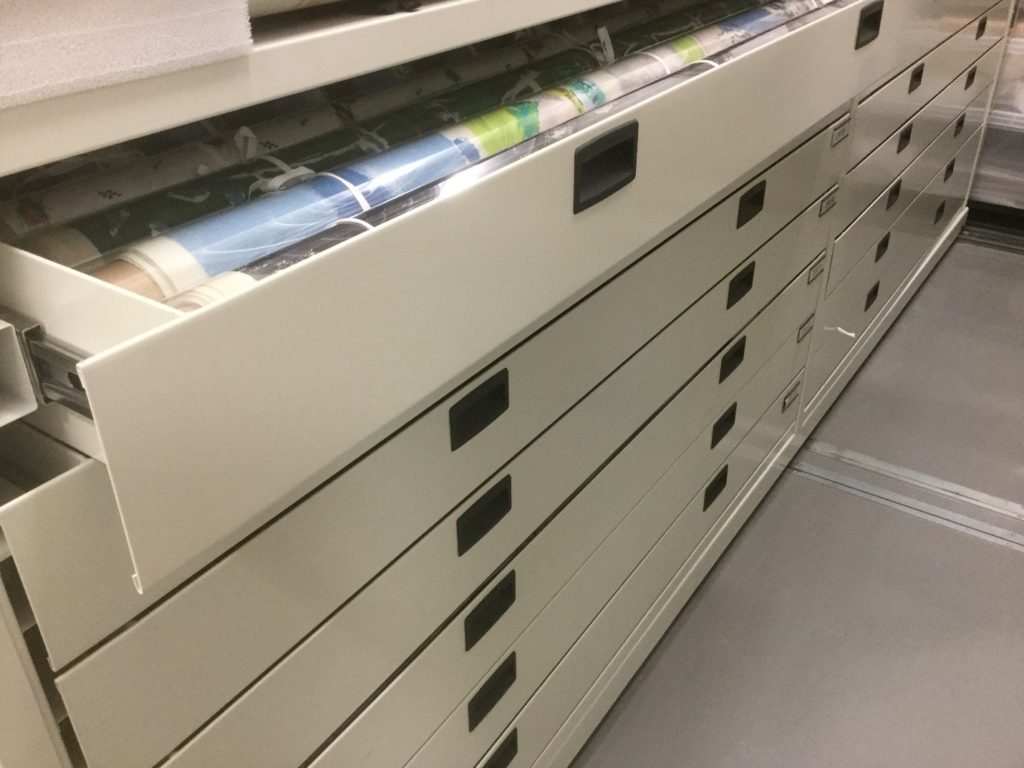
by Anna Robinson, first year student MPhil Textile Conservation.
In the last week of October, the first-year students paid a visit to the Whitworth Art Gallery at University of Manchester. At the Gallery, we were treated to a whirlwind tour, including both public and behind-the-scenes spaces by the museum’s textile conservator, Ann French. The tour provided the class a chance to explore the Whitworth’s extensive textile collection, as well as discuss the challenges and opportunities associated with the role of conservators within museums.


During the tour, Ann provided us with an opportunity for open and frank discussion about her experiences with the Whitworth collection and space, associated challenges, and real-world solutions and adaptations. One of the biggest challenges the Whitworth faces is balancing the access to and storage of their collection. Like most museums, they are working with finite staffing, financial, and spatial resources facilitating the need for long-lasting solutions that do not require continued input of extensive time or money. While going through the Gallery, I observed a clear theme to the tour, the standardization of collections storage.
Collections storage standardization is done by using uniformly sized storage mounts, rolls, and boxes, which fit neatly together in order to maximize storage space. The meticulous and tidy storage of both collection and supplies accomplished at The Whitworth through standardization of storage mounts, boxes, and systems would make Marie Kondo proud. As someone who has spent over half a decade working in an equally sized museum, I was in awe, and seeing what Ann had accomplished definitely sparked joy.
Though Ann has been working on this project for most of her 17 years at the gallery, it seems the standardization of collections storage was able to become more fully realized with the completion of gallery renovations in 2015. This in turn allowed for significant improvements and expansion of both their storage and display areas.
The improved collections storage areas are three rooms located in the original gallery’s Victorian era basement. Each room, lined with compact rolling storage, is organized primarily by the storage requirements for the object, opposed to more traditional methods of artist, style, or time period. Garments in their dust covers, hang grouped in the closet-like spaces of the compact rolling storage, while rolled textile swatches rest in bottomless drawers fitted with end supports to prevent unnecessary compression of the textiles. The storage upgrade also included adapting several pre-existing storage methods to the new system, including two sets of large drawers, many tray-style boxes, as well as, utilizing awkward spaces, such as the small alcoves along the walls of the stores which are used to hold additional packing and mounting materials.
While the organization of the collection by storage requirements in order to best utilize space may seem counter-intuitive to collection accessibility, careful planning and consideration for the needs of curators and researchers is evident in the meticulous labeling and the use of Mylar wrappings for rolled items, allowing perusers to find and identify the objects of their interest.

Rolled textile storage at the Whitworth. Photo courtesy of Ann French, 2019.
Over all, the trip to the Whitworth Art Gallery provided the first-years with insight into the various aspects to a conservator’s role including, navigating the needs of clients, organizations, and colleagues in a manner that promotes collections care, and how conservation professionals fit into a museum structure. The storage arrangement offered a unique real-world example of how storage can impact multiple aspects to how a museum operates.

